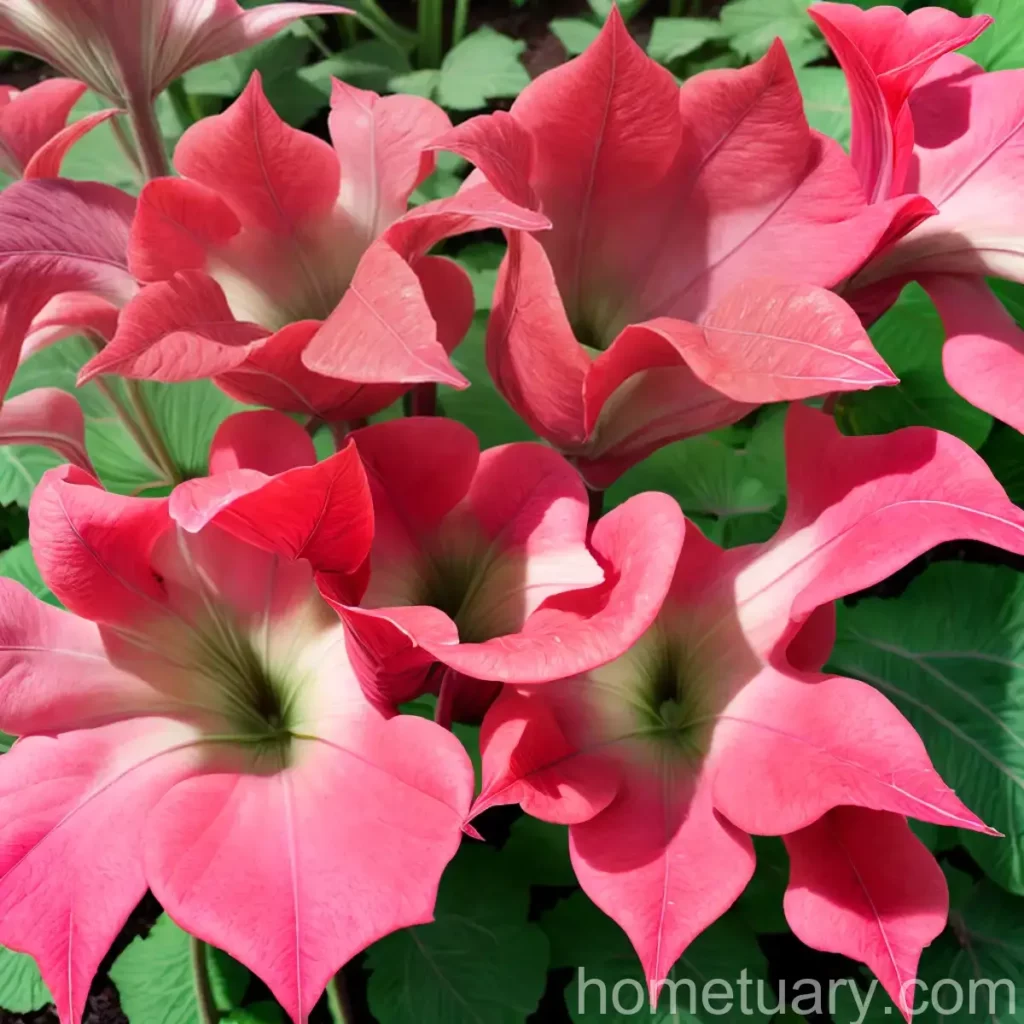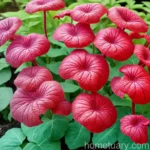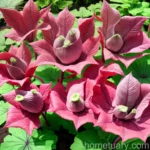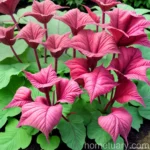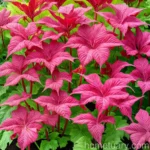The Versatile Rhubarb Plant: A Complete Guide to Growing and Caring for Rhubarb (Rheum x hybridum ‘Valentine’)
Introduction
Rhubarb (Rheum x hybridum ‘Valentine’) is a versatile and resilient plant that is cherished by gardeners and culinary enthusiasts alike. Its vibrant red stalks and unique tart flavor make it a favorite ingredient in pies, jams, and sauces. Beyond its culinary uses, rhubarb is also prized for its ornamental qualities and hardiness in various growing conditions. In this comprehensive guide, we will delve into the essential aspects of cultivating and caring for rhubarb, from its preferred growing environment to common diseases and pests that may affect its health.
What is Rhubarb (Rheum x hybridum ‘Valentine’)?
Rhubarb, scientifically known as Rheum x hybridum ‘Valentine’, is a perennial plant belonging to the family Polygonaceae. It is a hybrid variety that is widely cultivated for its edible stalks, which are used in a variety of culinary applications. The ‘Valentine’ variety is particularly beloved for its deep red stalks and exceptional flavor.
Key Takeaways – Rhubarb (Rheum x hybridum ‘Valentine’)
Rhubarb (Rheum x hybridum ‘Valentine’) is cherished for its culinary uses, ornamental qualities, and resilience in diverse growing conditions. Here are the key takeaways when it comes to understanding and cultivating this versatile plant:
-
Nutrition: Rhubarb is a good source of vitamins and minerals, including vitamin K, vitamin C, calcium, and potassium. Its stalks are low in calories and high in fiber.
-
Cultivation Tips: Successful cultivation of rhubarb requires attention to soil quality, sunlight, water, and fertilizer. Proper care is essential for optimal growth and abundant harvests.
-
Growing in Gardens: Rhubarb thrives in well-drained, fertile soil with plenty of sunlight. It is well-suited for garden beds and larger outdoor spaces.
-
Care Guide: Regular watering, proper soil amendments, and occasional fertilization are essential for maintaining the health and vigor of rhubarb plants.
-
Benefits of Growing Rhubarb: Beyond its culinary appeal, growing rhubarb can contribute to a sustainable garden ecosystem and provide a reliable source of fresh produce.
-
Plant Diseases: Rhubarb is susceptible to certain diseases, including fungal infections and bacterial blights. Vigilant monitoring and disease prevention strategies are crucial for plant health.
-
Soil Preferences: Rhubarb thrives in well-drained, fertile soil with a slightly acidic to neutral pH. Proper soil preparation is key to successful cultivation.
-
Varieties: There are numerous rhubarb varieties, each with distinct characteristics in terms of flavor, color, and growth habits.
-
Pests and Control: Common pests such as aphids, mites, and snails can pose a threat to rhubarb plants. Integrated pest management practices are important for pest control.
-
Harvesting: Harvesting rhubarb at the right time and in the correct manner promotes continued plant growth and ensures a bountiful yield.
Culture
The cultivation of rhubarb requires careful attention to its specific cultural requirements. From the ideal growing environment to maintenance practices, understanding the cultural needs of rhubarb is essential for successful cultivation.
Uses
Rhubarb is prized for its versatile uses, both in culinary and ornamental contexts:
-
Culinary Purposes: The edible stalks of rhubarb are used in a variety of desserts, including pies, crisps, and compotes. They can also be cooked down into preserves and sauces, adding a tangy flavor to the dishes.
-
Ornamental Qualities: Beyond its culinary uses, rhubarb adds aesthetic appeal to gardens and landscapes with its large, lush foliage and vibrant stalks. It can be used as a decorative border plant or as a focal point in ornamental gardens.
Water
Proper watering is essential for the health and vitality of rhubarb plants. While they are relatively resilient and drought-tolerant once established, consistent moisture is crucial, particularly during the growing season and in hot, dry weather.
-
Watering Schedule: Rhubarb plants benefit from regular watering, especially during dry spells. Aim to keep the soil evenly moist but not waterlogged.
-
Avoid Overwatering: While adequate moisture is necessary, overwatering can lead to root rot and other water-related issues. Ensure that the soil has good drainage to prevent waterlogging.
Sunlight
Rhubarb plants thrive in full sun to partial shade, with a preference for at least 6 hours of direct sunlight daily. Adequate sun exposure ensures robust growth and strong stalk development.
-
Sun Requirements: Choose a planting location that receives ample sunlight throughout the day, especially in the morning and early afternoon.
-
Shade Tolerance: While rhubarb prefers full sun, it can also tolerate partial shade, particularly in regions with intense afternoon sun or high temperatures.
Fertilizer
Proper fertilization contributes to the overall health and productivity of rhubarb plants. It is important to provide essential nutrients to support vigorous growth and abundant yields.
-
Organic Matter: Incorporating well-rotted compost or aged manure into the soil prior to planting provides a nutrient-rich foundation for rhubarb.
-
Balanced Fertilizer: As the plants continue to grow, applying a balanced fertilizer with a higher potassium content can promote healthy stalk development and overall vigor.
Soil
Rhubarb thrives in well-drained, fertile soil with a slightly acidic to neutral pH. Soil preparation before planting is crucial to create an optimal growing environment for rhubarb.
-
Soil Composition: A loamy, well-drained soil with good fertility and sufficient organic matter is ideal for rhubarb cultivation.
-
pH Level: Aim for a soil pH of 6.0 to 7.0, which is favorable for rhubarb growth. Amending the soil with lime or sulfur can help adjust the pH if needed.
Pruning
Pruning plays a role in maintaining the health and vigor of rhubarb plants. While minimal pruning is required, removing old or damaged stalks and flower stalks can promote continued growth and productivity.
-
Spring Pruning: In early spring, remove any remaining older stalks from the previous growing season to make way for new growth.
-
Flower Stalk Removal: Regularly remove flower stalks as they emerge to redirect the plant’s energy towards stalk production rather than seed formation.
Propagation
Rhubarb can be propagated through division, allowing gardeners to expand their rhubarb collection or share plants with others. Division is typically carried out in early spring or fall when the plants are dormant.
-
Division Process: To divide rhubarb, carefully lift the plant and separate the crowns into distinct sections, ensuring that each division has viable buds and roots.
-
Planting Divisions: Replant the divided sections in prepared soil, ensuring proper spacing and adequate watering to support establishment.
Container Popularity
While rhubarb is commonly grown in garden beds, it can also flourish in containers, offering a space-saving option for gardeners with limited outdoor space.
-
Container Requirements: Select spacious containers with adequate drainage holes to accommodate the extensive root system of rhubarb.
-
Soil Considerations: Fill the containers with well-draining, nutrient-rich soil to support healthy growth and development.
Common Diseases
Rhubarb is susceptible to certain diseases that can impact its overall health and productivity. Recognizing the symptoms of these diseases is crucial for prompt intervention and management.
-
Fungal Diseases: Common fungal diseases that affect rhubarb include leaf spot, powdery mildew, and crown rot. These can cause leaf discoloration, wilting, and overall decline in the plant’s health.
-
Bacterial Blights: Bacterial blights, such as bacterial leaf spot and crown gall, can also affect rhubarb, leading to lesions and abnormal growth.
Disease Diagnosis
Prompt diagnosis of diseases is essential for implementing effective treatment and prevention measures. Visual inspection and proactive monitoring can help identify disease issues early on.
-
Symptom Recognition: Familiarize yourself with the common symptoms of fungal and bacterial diseases that affect rhubarb, including leaf discoloration, wilting, and unusual growth patterns.
-
Expert Consultation: If you suspect disease issues with your rhubarb plants, seek advice from local agricultural extension services or plant health professionals for accurate diagnosis and recommended strategies.
Common Pests
Several pests can pose a threat to rhubarb plants, affecting their growth and overall vigor. Implementing pest control measures is essential for protecting the plants from potential damage.
-
Aphids: These small, sap-sucking insects can infest rhubarb plants, causing wilting, stunted growth, and deformation of new leaves and shoots.
-
Slugs and Snails: These mollusks can feed on the leaves and stalks of rhubarb, leading to visible damage and reduced plant vitality.
Botanist’s Tips
Expert insights and recommendations from botanists and experienced gardeners can offer valuable guidance for cultivating and caring for rhubarb plants.
-
Soil Testing: Conduct regular soil tests to assess the pH and nutrient levels, allowing for targeted soil amendments to optimize growing conditions for rhubarb.
-
Integrated Pest Management: Implementing integrated pest management practices, including beneficial insect conservation and natural predators, can help control pest populations without relying solely on chemical interventions.
Fun Facts
Rhubarb is a fascinating plant with a rich history and intriguing characteristics that make it a captivating addition to gardens and landscapes.
-
Historical Significance: Rhubarb was historically used for medicinal purposes in ancient China and has a storied culinary tradition in European and North American cuisine.
-
Ornamental Appeal: In addition to its culinary uses, rhubarb plants add visual interest to gardens with their large, textured leaves and striking red stalks.
Links to External Resources
Enhance your knowledge of rhubarb cultivation and care with the following external resources:
- Rhubarb: Planting, Growing, and Harvesting Rhubarb
- Growing Rhubarb in the Home Garden
- Rhubarb: A Vegetable, Fruit, and Food Crop
- Rhubarb: Tips for Growing the Piquant Perennial
- Ohio State University Extension Fact Sheet: Growing Rhubarb
Rhubarb plants are a valuable addition to any garden, offering both culinary delights and visual appeal. By understanding and meeting their specific growing requirements, you can cultivate thriving rhubarb plants and enjoy a bountiful harvest of delicious, tangy stalks. Whether you are a seasoned gardener or a novice enthusiast, the allure of growing and caring for rhubarb is undeniable, and the rewards are truly satisfying.

